LUC VAN PUYMBROECK and CHRISTOPHE ROHART, VAM Drilling
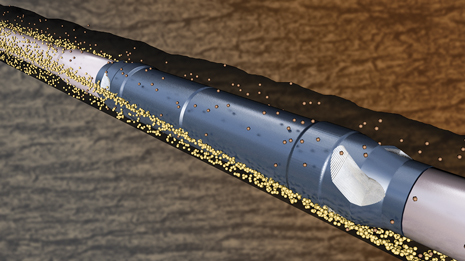 |
| Specially machined grooves improve cuttings transport efficiency of the Hydroclean drill pipe. |
|
While hole cleaning during drilling is generally considered to be well understood and a requirement for reaching the well target, many drillers still have difficulty properly managing the entire process. Less-than-optimal hole cleaning can lead to non-productive time, poor borehole quality, and loss of the drill string or even loss of the well.
HOLE-CLEANING ISSUES
Cuttings in highly deviated wells have a tendency to accumulate on the low side of the wellbore. As the flow velocity of the drilling mud becomes insufficient to maintain a clean hole, cutting beds start to develop. Large boreholes above 30° inclination drilled at high ROPs are most critical, and will usually require additional clean-out procedures. In practical terms, the drilling and clean-out process usually includes some combination of high rotational speed and flowrates, reciprocating, pumping sweeps, wiper trips, circulating multiple bottoms up, slow tripping, reaming and back-reaming.
Hole-cleaning issues have an impact on drilling performance, especially offshore. Land drilling operators, however, are more inclined to accept the necessity of addressing these issues with time-consuming procedures, which increase drilling cost and risk. Cuttings start to load up the well from the bottom up immediately after drilling has started when drilling appears to be going well. The paradox with maintaining cuttings at acceptable levels is that buildup will go unnoticed until symptoms from the well signal a growing issue. If left unattended, the problems become obvious when indicators such as reduced ROP, the need for higher WOB, erratic drilling torque, non-uniform rate of cuttings over the shakers, pipe buckling, high annular pressures, ECD out of the window, drill string whirl, twist-off and stuck pipe events present themselves. Remedies, red flags simply by being necessary, include additional wiper trips, sweeps, long circulating times and other well-known rig practices.
Hole-cleaning “rules” change in smaller hole sizes (less than 8½-in.) and even more so in horizontal wells. Excessive annular pressure and higher Equivalent Circulating Densities (ECD) can rapidly develop, with the cuttings tending to settle in saltation, and cutting beds forming on the low side of the well. This problem can be exacerbated by the increased horizontal length of the wellbore, and is particularly prevalent in ERD wells. The idea that pipe rotation and high pump rates will keep cuttings in suspension is flawed due to the misconception that the cutting transport to surface is uninterrupted. The laws of physics determine that as little as 20% of the total cuttings are kept in suspension at any given time. Evidence is seen in the irregular cutting volumes coming over the shakers, the tripping behavior of string and other indicators. A good approach to optimize rig time is to incorporate good hole-cleaning practices with continuous monitoring of the well.
ADDRESSING HOLE CLEANING
The consequences of poor hole cleaning can cause problems that are difficult to solve, especially when the borehole quality is downgraded. Loss of circulation is a typical example of this, and is commonly encountered in ERD wells. The industry recognized the problem early on, estimating the cost to be roughly $800 million per year globally (Ivan et al., 2004). This figure is likely to be higher today.
In many respects, the first approach to hole cleaning can look quite simple when only considering cuttings behavior by rotation of the drillstring and cuttings displacement by the circulation of the drilling fluid. Mud rheology plays a major role, but mud is only one part of an engineered system approach, which requires all the factors affecting cuttings behavior to be addressed. Analyzing cuttings ground by drillstring rotation and cutting rates over the shakers is a first step towards developing hole-cleaning key performance indicators.
Efficient cuttings transport and keeping the well clean enough for trouble-free operations usually dictate how much time is spent cleaning the hole. Evaluation and performance analysis for drill string optimization, flat times, ECD, and torque and drag are also used for setting targets. The execution at the wellsite usually requires the drilling team to manage pre-established rig procedures to achieve real-time performance improvement through constant monitoring of the wellbore. For example, pick-up weight is one of the performance indicators measured while tripping in and out of the hole and reciprocating the drill string. Diligent hole-cleaning practices while tripping in with controlled axial speed and set flowrates, rotational speed at minimum levels, and ECD controls while moving the string upwards are other examples of hole-cleaning procedures. Measurement of pressure while drilling is routinely applied for monitoring cutting bed height equilibrium close to the bit and used as an indicator of out-of-control hole cleaning.
Tight hole situations can result in nonproductive time and lead to stuck pipe, wellbore instability, loss of circulation, fishing jobs and technical sidetracks, all of which are more prevalent in ERD wells. One way to mitigate these issues is with a system approach. An in-depth performance analysis review of the entire drilling process with emphasis on maximizing drilling is usually required. Once this analysis is completed, mechanical hole-cleaning devices (MCDs) can be considered.
HYDROMECHANICAL DEVICES
A more efficient approach involves using hydromechanical hole-cleaning devices such as the Hydroclean. These tools have been used extensively offshore to drill 17½-in. and 12¼-in. directional wells. As a result of the hydrodynamic and hydromechanical effects, the tool gradually reduces cutting beds height by mechanical erosion where they cannot be avoided under normal drilling conditions. Cuttings are continuously scooped and sustained for transport above the drill pipe in the high-fluid-velocity area of the annulus, Figs. 1, 2. Increased drilling performance can be achieved with less time spent conditioning the hole.
 |
| Fig. 1. Hydromechanical cleaning action |
|
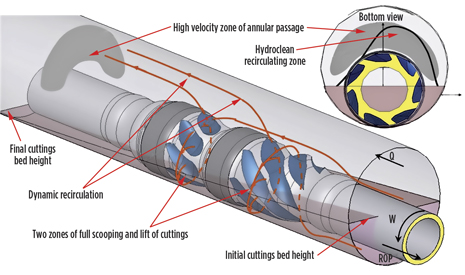 |
| Fig. 2. Hydroclean drill pipe mechanical design supports scooping and eroding of the cuttings beds and conveyor belt recirculation. |
|
Although the Hydroclean tool has been used worldwide, few studies have been conducted showing how drilling performances can be improved with an all-inclusive system approach. Results ranging from total success to disappointment have been experienced. Such outcomes are usually predictable, because of the need to create the correct environment and to follow a blueprint including a hole-cleaning management system with defined expectations and deliverables. The flowchart process should have a planning, execution and post-job review analyses, with lessons learned and quantifiable objectives for continuous improvement. For example, there is a minimum quantity of tools required in the drill string and a minimum RPM to achieve effective mechanical scooping of cutting beds. For additional benefits, the RPM can be increased to the threshold where “viscous coupling” between the pipe and the drilling fluid is achieved. Pre-defined rig procedures must be followed to maintain effective hole cleaning. One mistake is to use fewer than the minimum number of tools required, typically due to cost, thus defeating the purpose of the entire exercise. A few publications have demonstrated the value proposition of the Hydroclean technology.1-3
NEW HYDROCLEAN DRILL PIPE
A new drill pipe design from VAM Drilling, integrating hydromechanical cleaning features in each tool joint, has been developed to overcome the limitations of the increased diameter and weight of MCDs and to extend Hydroclean applications to ERD wells, Fig 3. The new Hydroclean drill pipe incorporates patented technology throughout the drill string and is designed to enhance drilling performance. This enables safer ECD margins and achieves optimal hole cleaning while drilling.
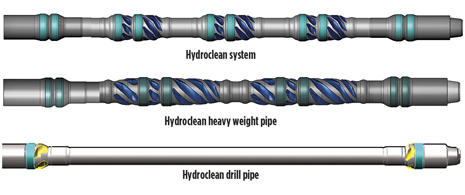 |
| Fig. 3. Hydroclean products |
|
Short of a full analysis with KPIs, performance improvements compared with standard drill pipe are expected as a result of efficiency gains obtained from three principles of MCDs; scooping and eroding cutting beds at each tool joint, moving and keeping cuttings continuously flowing on the high side of the hole, and maintaining the conveyor belt effect to sustain continuous transportation along the drill string while rotating cuttings.
CLEANOUT TESTING
The first tests were conducted on horizontal test beds with flowrates of 200, 300 and 400 gpm and rotational speeds between 50 rpm and 85 rpm. The drilling fluid consisted of water plus polymer weighted to 9.0 ppg, Fig. 4. At simulated ROP of 30 ft/hr and 50 ft/hr, the Hydroclean drill pipe increased the weights of cutting extracted by 40– 60% and reduced cleanup time by 60% compared to standard drill pipe. Cuttings bed height was reduced by 50%, Fig. 5.
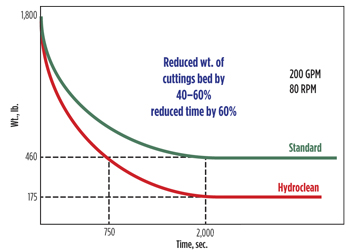 |
| Fig. 4. Hydroclean drill pipe reduced clean up time by 60%. |
|
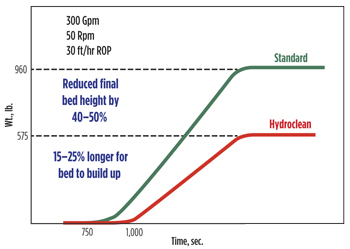 |
| Fig. 5. The final cuttings bed height was reduced by 40% to 50%. |
|
FIELD APPLICATION
Talisman Malaysia Ltd operates block PM-3 CAA located offshore east coast Malaysia, approximately 240 km northeast of Kertih, Terengganu. The first development was in 2002 with the installation of Bunga Kekwa-A platform, with a total of 10 wells drilled. Subsequent field development required installation of Bunga Kekwa-C, Bunga Raya-B, Bunga Raya-C and Bunga Seroja-A wellhead platforms to drill more wells of various utilities. Development drilling was carried out utilizing the jack-ups Harvey H Ward and Roger W Mowell.
Due to the high cost of hole cleaning and working tight holes, TML implemented a new hole-cleaning management procedure based on optimized operating parameters, including the Hydroclean HDP tool on the BK-C wells. The example BKC-14 well had approximately 1,700 m of 12¼-in. hole section with maximum inclination of 73°. Due to higher inclination, the main concern was avalanching behavior of cutting beds and the effectiveness in hole cleaning, which created tight hole operating conditions over such a long interval. Standard BHA design included PDC bit, MWD/LWD and the 65/8-in. Hydroclean heavyweight (HHW) and standard Hydroclean tool (HDP) to further assist cuttings removal. The 5-in. drill pipe was replaced with 5½-in. drill pipe to provide better hydraulics. Flowrates were maintained at 1,000 gpm while drilling the section. The use of drill collars was also discontinued, and replaced with 65/8-in. Hydroclean heavyweight (HHW) and Hydroclean tool (HDP) evenly spaced all the way up to 20° inclination in the well.
No hole-cleaning problems occurred while drilling the hole section. Directional control was excellent; no difficulties were experienced while sliding, with good steerability all the way to TD. The torque and drag remained below the predicted readings throughout. A few tight spots were encountered while tripping out of hole, indicating the hole might still have had some cuttings beds remaining. These situations were worked through using standard hole-cleaning practices and procedures.
Tripping to bottom with 95/8-in. casing was slick, with no excessive drag. A detailed time analysis of PM-3 BKC wells has shown significant reduction of non-productive times when drilling the critical 12¼-in. hole section. The significant time savings were identified at two levels: tripping time and cleaning time. Tripping time (in and out) was reduced due to lower and closer-to-normal pick-up weights with less drag, a consequence of better hole cleaning. The number of wiper trips were reduced or eliminated in some cases.
Based on a rig spread rate of $250,000/day, tripping time savings equivalent to of $9,000/day and wiper trip savings of $5,000/day were achieved. Considering seven drilling days for the 12¼-in. section, the direct savings added up to $100,000. Indirect cost savings included reduced equipment wear, while tight hole was nearly eliminated.
CONCLUSIONS
Field experience has already confirmed the benefits of using Hydroclean systems in highly deviated wells, with improvements at all levels of drilling. The technology as featured in the drill pipe joints offers new prospects for improving performances and reducing costs. It is also economically justifiable for conventional and unconventional onshore drilling operations. 
LITERATURE CITED
1. Ahmed, R.; M. Sagheerm, N. Takach, R. Majidi, M. Yu and S. Miska, University of Tulsa; and Rohard, Christophe; and J. Boulet, VAM Drilling, “Experimental studies on the effect of mechanical cleaning devices on annular cuttings concentration and applications for optimizing ERD systems,” SPE 134269 paper presented at the SPE Annual Technical Conference and Exhibition, Sept. 19-22, 2010, Florence, Italy.
2. Hapiztuddin, M., Talisman Energy; R. Elder, Certified Oilfield Rentals; J. Boulet and A. Monnet, Vam Drilling, “Maximizing Drilling Efficiencies in High-Angle Wells with New Hole Cleaning, Torque & Drag Reduction Systems: SPE/IADC World Drilling Conference and Exhibition, held in Paris, June 13-14, 2007.
3. Reinhardt, Randall W.; N. Williamson; L. F. Eaton S.C. Actis, “Magnolia deepwater development – striving for best-in-class drilling performance,” SPE 92439 paper presented at the SPE/IADC Drilling Conference, Feb. 23-25; 2005, Amsterdam, Netherlands.
|
The authors
LUC G. VAN PUYMBROECK is Global Product Line Manager – Marketing for VAM Drilling in Houston. Mr. Van Puymbroeck has 30 years of progressive managerial experience in the oil and gas industry. He holds a BS and MS degrees in Mechanical and Civil Engineering.
CHRISTOPHE ROHART joined VAM Drilling after graduating from the Ecole Polytechnique in Paris. Mr. Rohart is R&D manager for all new product developments with expertise in high-performance systems such as drill pipe riser and hole cleaning tools. |
|








